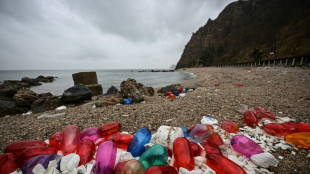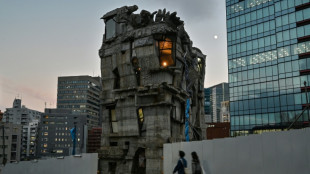
| RBGPF | 100% | 60.1 | $ | |
| CMSC | -0.65% | 24.57 | $ | |
| BCC | -2.76% | 148.41 | $ | |
| CMSD | -0.61% | 24.43 | $ | |
| AZN | -0.06% | 66.36 | $ | |
| NGG | -0.68% | 62.83 | $ | |
| RIO | -1.53% | 62.03 | $ | |
| SCS | -1.33% | 13.54 | $ | |
| BTI | 1.01% | 37.71 | $ | |
| GSK | -0.38% | 34.02 | $ | |
| RELX | 0.51% | 46.81 | $ | |
| RYCEF | -0.29% | 6.78 | $ | |
| JRI | -0.98% | 13.24 | $ | |
| BCE | -1.46% | 26.63 | $ | |
| BP | -1.24% | 28.96 | $ | |
| VOD | -0.56% | 8.86 | $ |

German court jails five over spectacular museum heist
A German court on Tuesday sentenced five gang members to up to six years in prison for snatching priceless 18th-century jewels from a Dresden museum in what media have dubbed the biggest art heist in modern history.
The thieves made off with a haul worth more than 113 million euros ($123 million) from the Green Vault museum in 2019. Some, but not all, of the loot was recovered in exchange for four of the defendants confessing in court.
The convicted men are members of the largely Berlin-based "Remmo clan", an extended family known for a web of ties to organised crime in Germany.
The court in the eastern city handed down three sentences ranging from just under to just over six years for armed robbery, aggravated arson and grievous bodily harm for the November 25, 2019 heist.
Two of the men, who were minors at the time of the crime, received juvenile sentences of five years and four years and four months respectively.
A sixth defendant was acquitted because he produced a credible alibi -- an emergency surgery at a Berlin hospital.
The plea deal came in for criticism, however, with Berlin prosecutors' association president Ralph Knispel noting the defendants had not been required to reveal their accomplices in exchange for lighter sentences.
"The question is what message that sends" to other criminals, Knispel told public broadcaster RBB.
- 'Remarkable criminal drive' -
The trial, which began in January 2022, shed some light on the spectacular heist but left key questions unanswered.
Although many of the historic pieces were recovered, some are feared lost forever in what prosecutors called an act of "remarkable criminal drive and recklessness" by the thieves.
The loot included a sword with a diamond-encrusted hilt and a shoulder piece which contained a 49-carat Dresden white diamond.
Prosecutor Christian Weber said on the opening day of the trial that the defendants had stolen "unique and irreplaceable treasures... of outstanding cultural and historical significance".
Two of the defendants, Wissam and Mohamed Remmo, were already serving time for the daring 2017 theft of a massive gold coin from a Berlin museum.
In a statement read in court in January by their lawyer, they said the idea for the Dresden job was hatched after a younger acquaintance "came back from a field trip to the Green Vault... raving about the green diamonds on display there".
The court found that the defendants, aged between 24 and 29, slipped into the museum through previously damaged bars on a window, broke a display case with an axe and grabbed 21 pieces decorated with 4,300 jewels in less than five minutes.
The thieves were able to escape in a getaway car that they later set ablaze in an underground car park.
For months after the crime, authorities thought the haul was lost for good, with detectives scouring Europe's shadowy stolen goods markets for signs of the Saxon royal artefacts.
- 40 suspects still wanted -
That was until December 2022, when authorities said they had recovered a "considerable portion" of the items following "exploratory talks" with the suspects.
Many of the pieces were badly damaged and some are still missing, however, including a brooch that belonged to Queen Amalie Auguste of Saxony.
In January, four of the defendants confessed, leading to the deal for lighter sentences.
A fifth said he stole tools to penetrate the building but denied taking part in the heist itself.
About 40 people believed to have been involved in planning the heist are still wanted.
The trial revealed grave security failings at the Green Vault, a state institution. Its director, Marius Winzeler, has said he is "optimistic" that the remaining missing pieces will one day return to Dresden, given they "cannot be legally sold".
Founded by Augustus, Elector of Saxony, in 1723, the Green Vault is one of Europe's oldest museums.
After the Royal Palace suffered severe damage in World War II, the museum remained closed for decades before it was restored and reopened in 2006 as a major tourist draw.
J.Fletcher--NG



